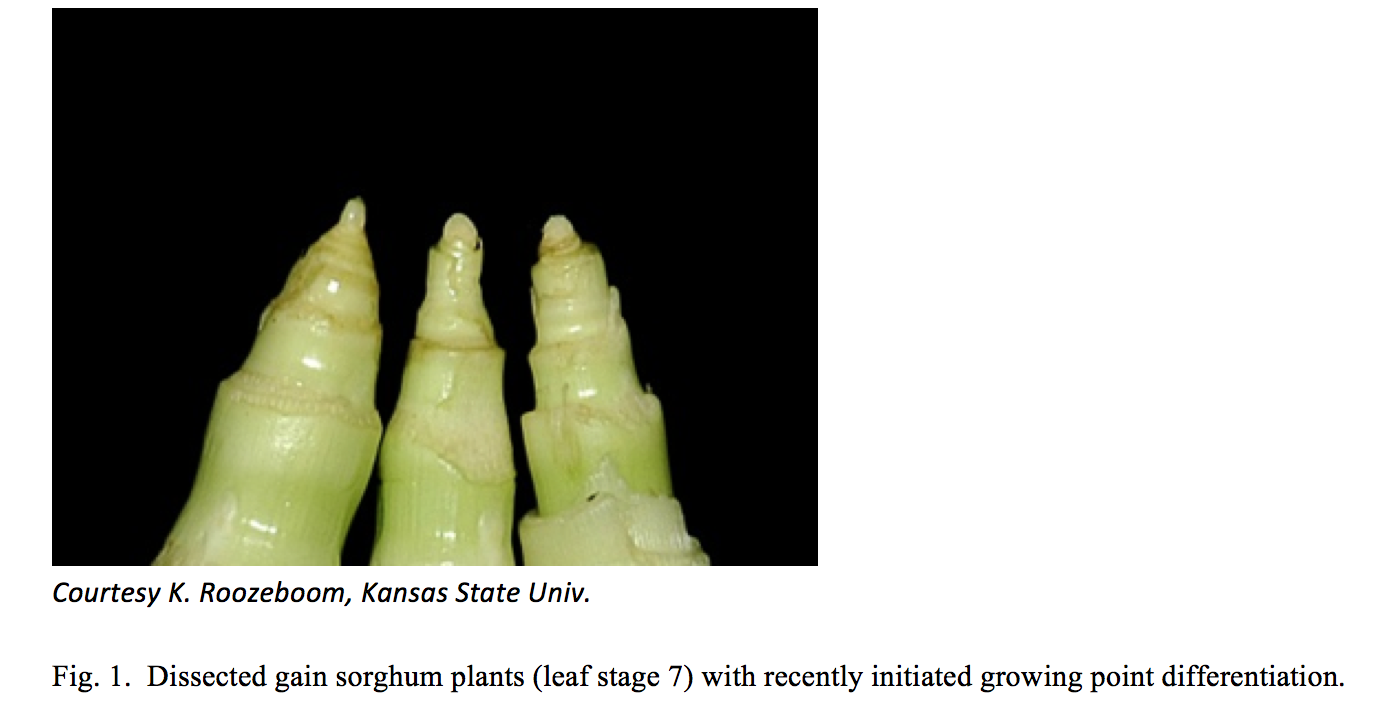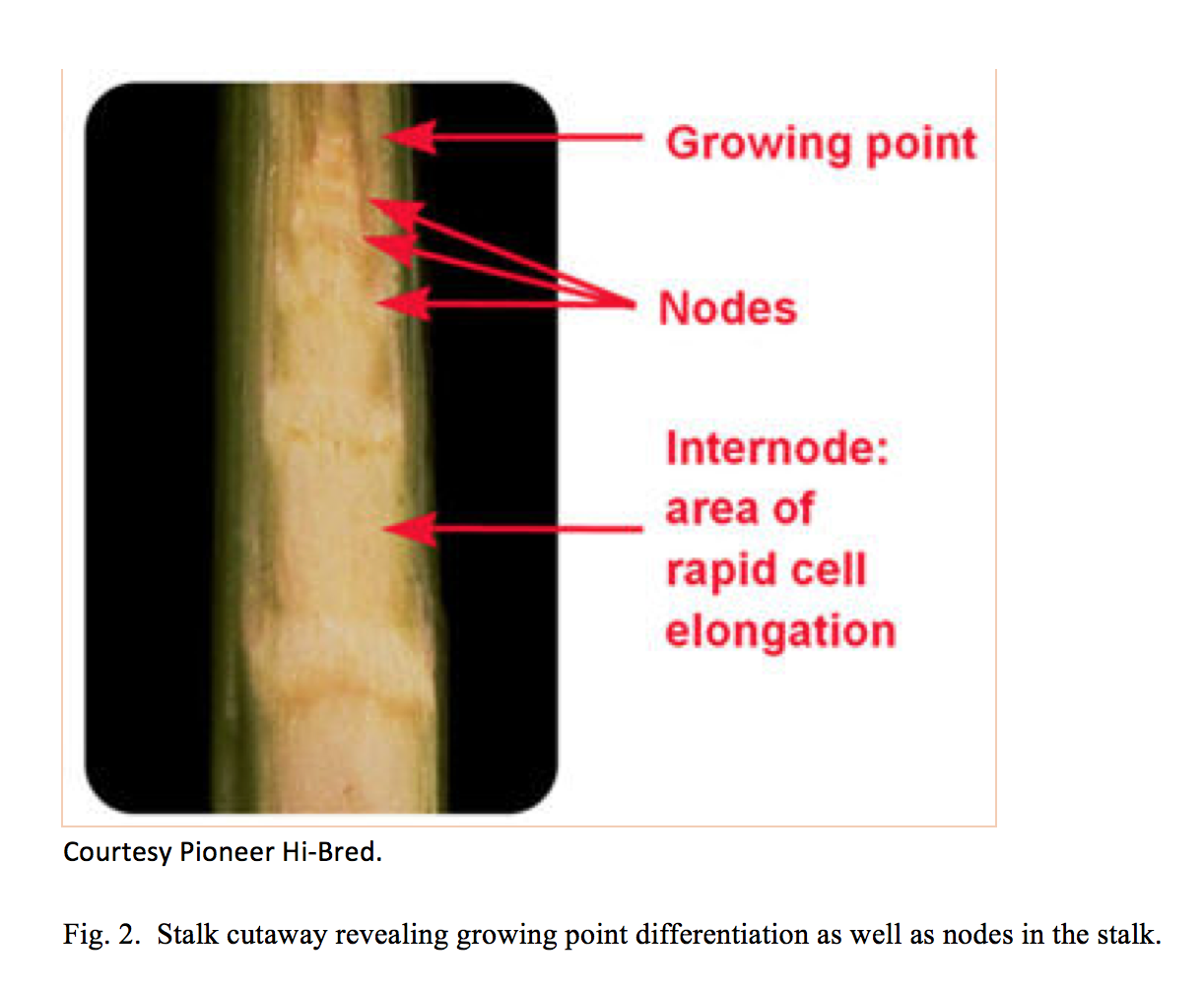This tip was provided by:
Calvin Trostle, Extension Agronomy, Lubbock, 806-746-6101, ctrostle@ag.tamu.edu
Statewide
Sorghum Physiology & Management III
This is the third of five Sorghum Tips AgriLife will share intermittently over fall and winter of 2017-2018. The first two discussed rooting issues and possible sidedressing applications in grain sorghum.
Physiology Driven Sorghum Management Consideration #3:
- Keys for optimizing grain sorghum production due to growing point differentiation.
Sorghum growers are often unaware of the connection between three sorghum management keys of production practices and growing point differentiation (GPD)—optimum timing of management is the purpose of capitalizing on and preserving grain sorghum’s yield potential. GPD is the process when the growing point switches over from producing another leaf to now developing the head, or panicle (Figs. 1 & 2). This process last for an individual head about 7 to 10 days. The number of spikelets (per head) and seeds (per spikelet) are determined, e.g. important component of yield potential. Unlike wheat (jointing) and other small grains (all members of the same family of grasses as are the sorghums), there is nothing external on the plant that would indicate this is happening. So, we need to rely on the calendar some to estimate when this is occurring, or cut the stems like in Fig. 2 to find the growing point.
Here are potential management keys that reflect the significance of GPD in grain sorghum production:
- Timing of in-season nitrogen fertilizer application. As nitrogen fertilizer is often applied after planting, most U.S. production guidelines recommend ensuring that the bulk of N is applied in advance or during GPD. This is similar to small grains production for the same reason: providing adequate N nutrition during GPD aids in ensuring sorghum panicle development is not limited thus setting higher grain yield potential earlier in the growth of the sorghum plant. Similar to irrigation noted below, nitrogen applied after completion of GPD will have less value for achieving maximum yield potential.
- Herbicide injury potential. Growth regulator herbicides dicamba and 2,4-D may injure the growing point, which is particularly sensitive during differentiation. In particular, many producers do not realize the connection between growth stage and label restrictions for several herbicides. Common labeling instructs growers to apply over-the-top applications of dicamba and 2,4-D no later than approximately 8” tall (this corresponds to about leaf stage 5, or five fully formed leaves). This stage of growth is approximately four weeks after emergence. At this point further applications of dicamba or 2,4-D in sorghum up to 15” tall—approximately leaf stage 7 to 8—should use a drop nozzle or hooded sprayer to minimize contact of the herbicide on the leaves and especially deposition in the whorl. This practice reduces the exposure of sensitive developing GPD tissues to herbicide and the potential subsequent injury in the developing head, which is above the soil line, but still well down in the stalk. Significant dicamba or 2,4-D injury may lead to blanking or sterility in the heads with little grain development.
- Timing of irrigation, if available. When conditions are droughty irrigation applied at or just before GPD will preserve the development of yield potential by setting higher spikelet number and potential seeds per head. Irrigation applied after GPD is still important for yield potential, but it will not affect potential head size. An objection raised by farmers in rainfed conditions is that, without irrigation, there is nothing they can do about moisture supply during GPD—not true: foremost, reduced seeding rates, which should be considered anyway for lower rainfall and potentially droughty conditions afford more moisture per plant, which will enhance potential head size; likewise, soil moisture conservation practices (reduced tillage, maintenance of crop residues on the soil surface) will enhance the desired outcome of GPD.
Summary:
The summation of management of grain sorghum around GPD is all about developing and retaining higher yield potential. The maximum potential number of spikelets and seeds per spikelet—a major component of maximum yield potential—represent up to 70% of sorghum’s final grain yield, and is a result based on the seed number determined during GPD over a period of seven to 10 days.










